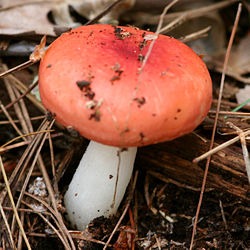Russula
| Russula | |
|---|---|

| |
| The Sickener (R. emetica) | |
| Scientific classification | |
| Kingdom: | |
| Subkingdom: | |
| Phylum: | |
| Subphylum: | |
| Class: | |
| Order: | |
| Family: | |
| Genus: | Russula Pers. 1797
|
| Diversity | |
| c.700 species | |
Around 750 worldwide species of mycorrhizal mushrooms compose the genus Russula. They are typically common, fairly large, and brightly colored - making them one of the most recognizable genera among mycologists and mushroom collectors. Their distinguishing characteristics include a white to dark yellow spore print, brittle free white gills, and an absence of partial veil or volva tissue on the stem. Members of the related Lactarius genus have similar characteristics but emit a milky latex when their gills are broken. The genus was described by Christian Hendrik Persoon in 1796.
Identification
Like the genus Lactarius, Russulas have a distinctive flesh consistency, which is also reflected in the appearance of the gills and stipe, and normally makes them immediately recognizable. They have no trace of a veil (no ring, or veil remnants on the cap). The gills are brittle except in a few cases, and cannot be bent parallel with the cap without breaking. The spore powder varies from white to cream, or even orange.
While it is relatively easy to identify a sample mushroom as belonging to this genus, it is a significant challenge to distinguish member species of Russula. This task often requires microscopic characteristics, and subtle subjective distinctions, such as the difference between a mild to bitter and a mild to acrid flavor. Moreover the exact phylogenetic relationships of these mushrooms have yet to be resolved in the professional mycological community, and may ultimately depend on DNA sequencing analysis.

The following characteristics are often important in identifying individual species:
- the exact colour of the spore powder (white/cream/ochre),
- the taste (mild/bitter/acrid),
- colour changes in the flesh,
- the distance from the centre to which the cap skin can be pulled off: (peeling percentage).
- cap colour (but this is often very variable within one species),
- reaction of the flesh to ferrous sulphate (FeSO4), formalin, alkalis, and other chemicals,
- ornamentation of the spores, and
- other microscopic characteristics, such as the appearance of the cystidia in various mounting reagents.
Despite the difficulty in positively identifying collected specimens, the possibility to spot the toxic species by their acrid taste makes some of the mild species, such as R. cyanoxantha and R. vesca, popular edible mushrooms. As far as is known, no species of Russula is deadly poisonous and mild-tasting ones are all edible. [1] Note that this rule applies only to Russulas and not to other types of mushrooms! see http://www.mtsn.tn.it/russulales-news/pdf/macro_form.pdf
Toxicity
The main pattern of toxicity seen among Russula species to date has been gastrointestinal symptoms in those with a bitter taste when eaten raw or undercooked; many of these are red-capped species such as R. emetica, R. sardonia and R. nobilis. However, rhabdomyolysis was seen after consumption of R. subnigricans in Taiwan. Several active agents have been isolated; one designated russuphelin A by researchers in Japan.[2]
Species
- For more examples, see the List of Russula species.
 Russula cyanoxantha - one of the largest species, with blue to greenish cap, mild taste and white, greasy gills.
Russula cyanoxantha - one of the largest species, with blue to greenish cap, mild taste and white, greasy gills. Russula emetica - so acrid it can be dried and powdered to make a chilli pepper substitute;
Russula emetica - so acrid it can be dried and powdered to make a chilli pepper substitute; Russula subnigricans - a poisonous mushroom causing rhabdomyolysis in Taiwan.
Russula subnigricans - a poisonous mushroom causing rhabdomyolysis in Taiwan. Russula virescens - an excellent mushroom, easily recognizable by the green and distinctly crackled cap cuticle;
Russula virescens - an excellent mushroom, easily recognizable by the green and distinctly crackled cap cuticle; Russula xerampelina - an edible russula that smells and tastes like shrimp or seafood;
Russula xerampelina - an edible russula that smells and tastes like shrimp or seafood;
See also
References
- ^ See "Russulales News", "Edibility and toxicity of Russulales" page, "5.1.2. Edible Russulae" section.
- ^ Takahashi A, Agatsuma T, Matsuda M, Ohta T, Nunozawa T, Endo T, Nozoe S (1992). "Russuphelin A, a new cytotoxic substance from the mushroom Russula subnigricans Hongo". Chem Pharm Bull (Tokyo). 40 (12): 3185–88. PMID (abstract) 1294320 (abstract).
{{cite journal}}:|access-date=requires|url=(help); Check|pmid=value (help)CS1 maint: multiple names: authors list (link)
- Arora, D. (1986). Mushrooms demystified: A comprehensive guide to the fleshy fungi, Berkeley: Ten Speed Press. pp. 83-103.
- Kibby, G. & Fatto, R. (1990). Keys to the species of Russula in northeastern North America, Somerville, NJ: Kibby-Fatto Enterprises. 70 pp.
- Weber, N. S. & Smith, A. H. (1985). A field guide to southern mushrooms, Ann Arbor: U Michigan P. 280 pp.
- Moser, M. (1978) Basidiomycetes II: Röhrlinge und Blätterpilze, Gustav Fischer Verlag Stuttgart. English edition: Keys to Agarics and Boleti... published by Roger Phillips, London.
- Partly translated from Dutch page.
